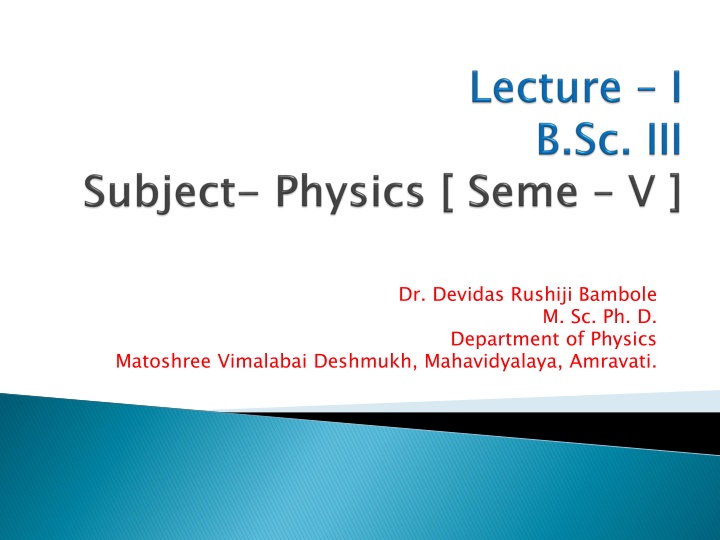
Photoelectric Effect: Theory, Experiments, and Applications
Explore the historical background, Planck's quantum theory, wave-particle duality, matter waves, Heisenberg's uncertainty principle, and the fascinating phenomenon of the photoelectric effect. Learn about the impact of frequency on electron emission and the principles underlying this significant aspect of quantum physics.
Download Presentation

Please find below an Image/Link to download the presentation.
The content on the website is provided AS IS for your information and personal use only. It may not be sold, licensed, or shared on other websites without obtaining consent from the author. If you encounter any issues during the download, it is possible that the publisher has removed the file from their server.
You are allowed to download the files provided on this website for personal or commercial use, subject to the condition that they are used lawfully. All files are the property of their respective owners.
The content on the website is provided AS IS for your information and personal use only. It may not be sold, licensed, or shared on other websites without obtaining consent from the author.
E N D
Presentation Transcript
Dr. Devidas Rushiji Bambole M. Sc. Ph. D. Department of Physics Matoshree Vimalabai Deshmukh, Mahavidyalaya, Amravati.
1.Historical Background: Failure of classical wave theory in explaining Black body radiation and Photoelectric Effect; Compton Effect Qualitative explanation only 2. Assumptions of Planck s Quantum Theory 3. Wave Particle Duality 4. Matter Waves: De Broglie Hypothesis, Davisson- Germer experiment 5. Concept of Wave Packet, Phase velocity, group velocity and relation between them. 6. Heisenberg s uncertainty principle: Different forms of uncertainty principle; Thought experiments: single slit diffraction and Gamma ray microscope
Definition frequency such as ultraviolet light or X-rays is incident on clean metal surface then electrons are emitted from the surface due to absorption of energy from electromagnetic radiation is called as the photoelectric effect are called as photo-electrons . As this effect first observed by Heinrich Hertz in 1887, this phenomenon is also known as the Hertz effect Definition:- when the radiations of high photoelectric effect and the emitted electrons
The frequency of the incident radiation The intensity of the incident radiation. P. D. between the electrodes Nature of the emitting surface. 1. 2. 3. 4.
Electrons can absorb energy from photons when they incident on metal surface. The absorption process follows the "all or nothing" principle. All of the energy from one photon must be absorbed and it is used to liberate one electron from atomic binding. If the photon energy is absorbed, some of the energy consumed in making the electron free from the atom, and the remaining amount of energy is given to the electrons as kinetic energy.
1. Effect of frequency on photoelectric effect: Effect of frequency on photoelectric effect:- - 1. Definition: certain minimum frequency of incident radiation below which no photoelectrons are emitted. This frequency is called the threshold frequency Definition: For a given metal, there exists a the threshold frequency.
From the graph it is observed that- photoelectric current is proportional to the intensity of the incident light.
The photoelectrons which are emitted with maximum kinetic energy are stopped by the stopping potential. Therefore, work done by the retarding potential on the fastest electron must be equal to the kinetic energy. e VC =
It is observed from the graph that as the frequency of the incident light is increased the stopping potential increases. Thus, if the Frequencies are in the increasing order 1 > 2 > 3 then corresponding stopping potentials are also in increasing order VC1 > VC2 > VC3
The magnitudes of stopping potential at different frequencies are converted into maximum K. E. i.e. e VC = The maximum kinetic energy is plotted against the frequencies. The straight lines are obtained as shown in the graph.
1. For a given photo-sensitive metal surface, there exists a certain minimum frequency 0 of incident radiation below which there is no emission of photoelectrons. This frequency is called the threshold frequency. The value of 0 depends on the material and nature of emitting surface. 2. For a given frequency > 0, the number of photoelectrons emitted per second from a given surface, under a constant accelerating potential drop is directly proportional to the intensity of incident radiation. Increase in intensity of incident beam (keeping the frequency fixed) increases the magnitude of the photoelectric current, though the stopping voltage remains the same.
3.The stopping potential for the photoelectrons and hence, the maximum kinetic energy is independent of intensity of radiation. 4. The maximum kinetic energy of photo-electrons emitted from given surface increases linearly with the frequency of incident radiation. A straight line meets the frequency axis at certain frequency 0, for the given surface. 5. The emission of photoelectrons is an instantaneous process. As soon as radiation of frequency greater than the threshold frequency is incident on given photosensitive surface there is emission of photoelectrons. The time lag between the incidence of radiation and the emission of a photoelectron is very small, less than 10 9 second.












